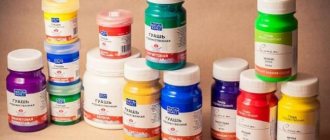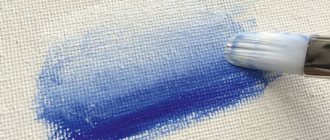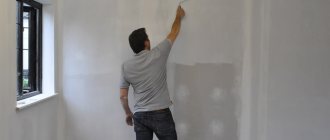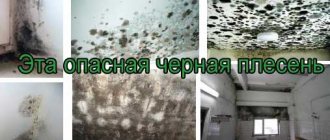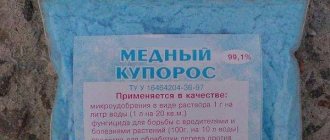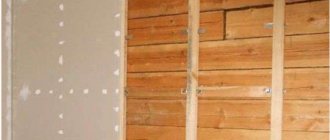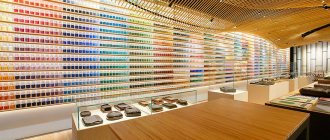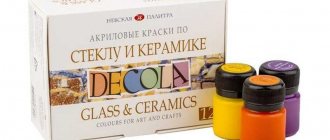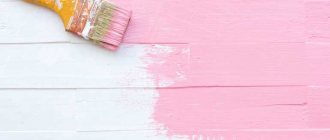Characteristics of gouache
Gouache is a water-soluble adhesive-based paint. It has a dense and matte structure due to the white in its composition. Often gouache becomes the second coating that an artist masters after watercolor.
Gouache is a water-soluble paint with a dense structure.
It is intended for coloring the following materials:
- paper;
- cardboard;
- primed canvas;
- fabrics;
- plywood.
The kaolin and white contained in the paint allow you to create dense layers without streaks or blurring of the base. With its help you can paint pictures in various techniques: watercolors, glazes, brush strokes. Errors can be easily corrected by using an additional layer: in this case, it is permissible to apply a lighter color to a dark one.
The finished coating has no shine, which makes the pattern soft and velvety. After drying, the painting takes on a whitish tint. The composition is prone to cracking with an impasto style of writing. Paintings painted in gouache must be protected from moisture, dust and direct sunlight.
At first, a novice artist should learn to work with gouache, since it takes longer to dry and dissolves in water even after drying.
The main differences between acrylic paint and gouache
Many masters recommend that aspiring artists use gouache to train their skills. But acrylic paints are ideal for professional painters with extensive creative experience. It is worth noting that you can purchase both acrylic paints and gouache at Officeton Market at competitive prices.
The main difference between acrylic is its low viscosity, so this paint is much easier and faster to apply. It dries quite quickly and needs to be constantly diluted with water if the artist prefers to paint slowly. When acrylic paints dry, they become darker, which is not the case with gouache, which, on the contrary, becomes lighter.
Another difference between gouache and acrylic is that gouache is washed away with water, but dried acrylic is unlikely to be washed off. If you mix gouache paint on a palette, it can be reused by adding water. Acrylic will remain dry.
When choosing suitable paints, you need to consider who will use them and for what purposes. This will help you choose the most optimal paint for your creativity and not make a mistake with your choice.
Source
Acrylic paint
Unlike gouache and watercolor paints, acrylic paints are more forgiving because they have a deeper and thicker base, as opposed to translucent and more water-based paints. Acrylic paint is used by artists who are willing to work quickly and carefully. Acrylic paint is more durable than gouache or watercolor in the sense that it does not fade as quickly when exposed to light, they can resist dust and they are waterproof. Paintings painted with acrylic paint will be much brighter than those painted with watercolors. Acrylic paints can be used with little to no water to create a thicker, more dramatic brush stroke. Acrylic can be used on a variety of surfaces such as paper, wood, glass, plastic, the list goes on. Watercolor can really only be used properly on paper. Basically, you can paint with acrylic paint in tow on anything. With acrylic, you can create clearer paintings and working lines, and even draw letters if necessary. You don't have this advantage when using watercolor. You also have the option of using other tools when working with acrylic, such as a palette knife, whereas this is not an option with gouache and watercolor paint.
So what's the problem?
Well, acrylic dries very quickly, which can be good or bad depending on the artist doing the painting. Another disadvantage of acrylic paint is that you cannot redo acrylic paint if it looks exactly like gouache paint. Acrylic is also slightly more expensive than its cousins, gouache and watercolor. To sum up the comparison between gauze, watercolor and acrylic As an artist, you need to understand what works best for you. While one artist might like the idea of restoring their painting after 10 years because they used gouache paint, another artist might prefer their painting to be frozen in time, knowing that it will remain the way they left it for many years. come. Although gouache, watercolor and acrylic paint may have their differences, they are all capable of creating a beautiful masterpiece.
Gouache
Gouache paint has been around for over 700 years, but, oddly enough, it is little known and not used. It consists of three main ingredients: pigment, binder and additives. Gouache is very similar to both acrylic and watercolor paint, but on its own. Gouache paint is opaque, but becomes translucent when water is added. When using gouache, you have the option of either diluting it with water or increasing the consistency of the paint. The end result, painted in gouache, is a shiny, vibrant piece of art with a matte finish. Compared to acrylic, gouache paint dries quickly, but can be worked on long after the work is completed. A piece decorated with acrylic paint can be placed directly in a frame, while a piece painted with gouache should either be glassed before framing or varnished upon completion. Watercolors and gouache are almost like cousins. It is available in small quantities and is usually mixed with water before painting. But look at this: Although gouache is similar to watercolor paint, it is different in that it is more pigmented, heavier, and provides more texture when painting. Another between watercolor paint and gouache paint is that a solid white pigment is added to the ingredients to create gouache paint using chalk or acrylic paint. Although gouache is not the only medium used, many artists have a lot to say when working with paint.
Difference between gouache and acrylic paint
Both experienced and novice artists care about painting their masterpieces. However, if the former have long ago decided on the choice of optimal paints, then the latter may be somewhat confused. On the one hand, I would like to give preference to bright, thick gouache. However, on the other side of the scale are acrylic paints, which today are extremely popular among creative people. What are the advantages and disadvantages of these materials? Let's try to figure out the difference between gouache and acrylic paint.
Definitions
Gouache is a type of water-soluble adhesive-based paint with a dense matte texture. The product has a rich history, because it was used in medieval Europe. However, the term arose only in the 18th century in France. During the Middle Ages, gouache in combination with watercolor was used to create book miniatures. Renaissance artists used the material to complete sketches and other preparatory work. The heyday of technology occurred at the end of the 19th – beginning of the 20th century. Domestic artists painted theatrical costumes and posters with gouache, created sketches of scenery and large easel works. By the way, the word gouache is translated from French as “water paint”. It is made from adhesive pigments mixed with white. The latter give the paint a spectacular matte velvety finish. Despite the fact that gouache is an independent technique, it is extremely rarely used by professional artists. Many artists consider it suitable only for creating children's drawings and designing posters.
Gouache
Acrylic paint is a water-dispersed paint made on the basis of polyacrylates and their copolymers. It is used both in painting and in construction when carrying out external and internal work. It acts as a worthy alternative to oil paints. It can be applied to paper or planes in liquid (with the addition of water) or paste form. The last option is the most popular among professional artists. Acrylic does not crack, lays down as an even film, is slightly shiny and does not require fixing. Sometimes the paintings he painted resemble works done with watercolors or oil paints. However, in most cases, acrylic has a unique color rendition that is unattainable in other areas of fine art. Largely due to this, he enjoys wide popularity among contemporary artists.
Acrylic paints
Comparison
The first difference lies in the composition of the products we are interested in. Gouache is made with the addition of white. In this regard, the paint after drying becomes significantly lighter and becomes matte. In general, the composition of gouache is similar to watercolor. Whereas water-dispersed acrylic has a structure similar to oil paints. It dries very quickly, which cannot be said about gouache. As long as the paint remains wet, it can be washed off with water without much difficulty. Acrylic is highly resistant, it does not fade in the sun, and does not spread when applying a new layer. With gouache everything is exactly the opposite. But it is much thicker and denser than acrylic paint. Due to the high content of coloring pigments, gouache is characterized by a very saturated color, and the pattern it creates is opaque. Acrylic paints lie on the surface much smoother, as if forming an invisible film on it. After drying they darken a little. Gouache gives a thicker and uneven layer. The transitions from one shade to another are quite abrupt.
Another significant difference between gouache and acrylic paint is the area of use of materials. As a rule, the first is used for drawing on paper of any thickness, and less often for painting fabrics. Acrylic is characterized by a wide range of applications. It is indispensable for painting ceilings, walls and other surfaces on a wooden or metal base. Creating drawings, painting on glass, decorating ceramic products, applying images to fabric and leather, airbrushing - the list of possibilities of acrylic paints is very extensive. This explains the relatively high cost of the material. If gouache is sold exclusively in sets with a certain number of jars in a box, then acrylic paints are often sold individually. They are bottled in a wide variety of bottles, be it miniature tubes of 20 ml or large bottles with the capacity of a standard glass.
